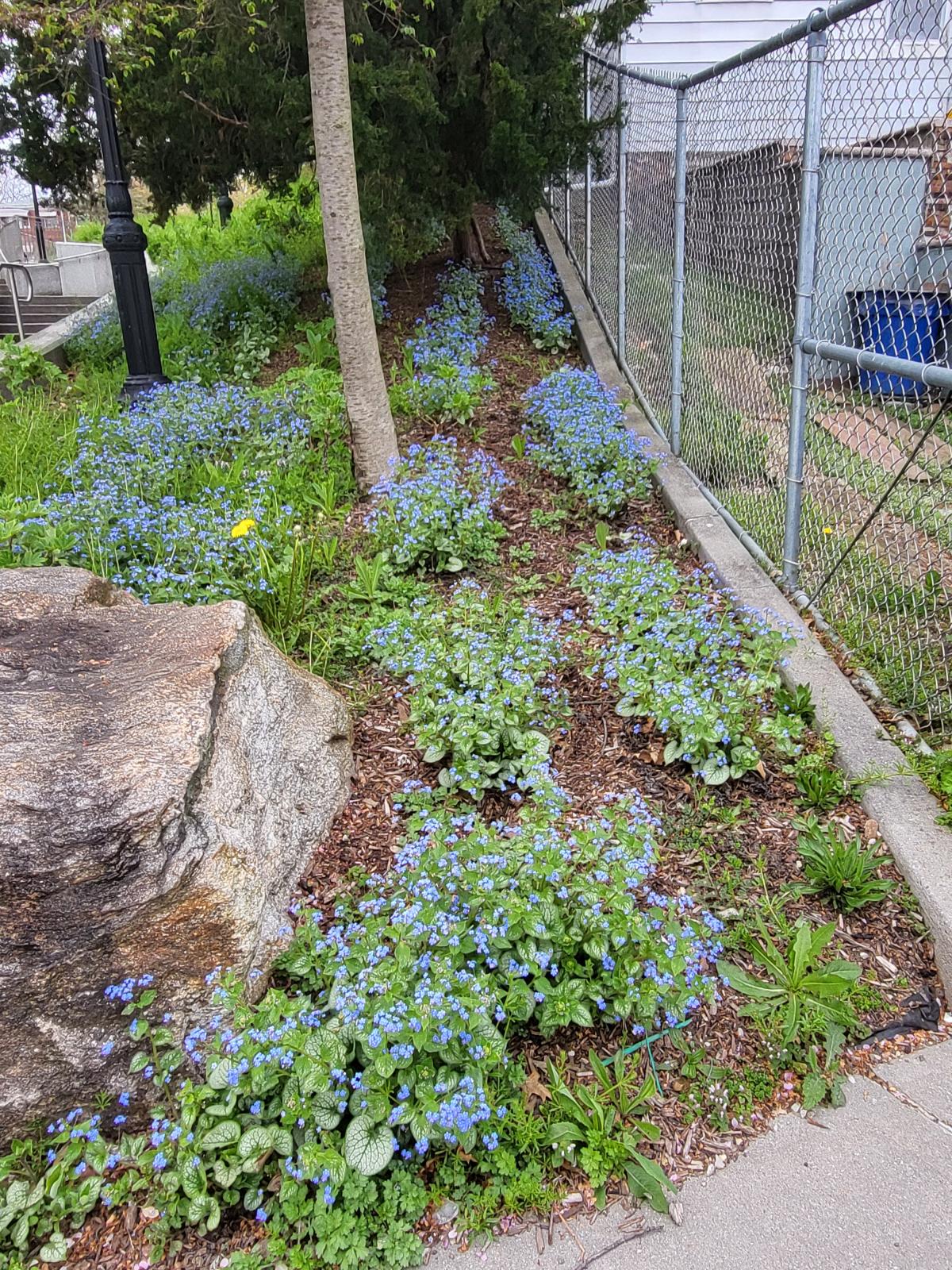Plant Finder
User Guidelines
The Plant Finder is a multi-faceted tool to assist designers, contractors, maintenance personnel, community groups and the general public in selecting plants that perform well within the public right-of-way. It expands on the lists included in previous versions of the Manual and should be used in conjunction with the guidance provided in the Landscape Chapter.
The Plant Finder database is not comprehensive and there is no guarantee that these plants will survive at a specific site. All plants within the public right-of-way must be selected based on site-specific conditions and approved by the appropriate agency or agencies with jurisdiction. Download the Plant Finder User Guide for instructions on how to use the tool.
The information in this database was generated by DOT, Parks, other agency staff, and local horticulture professionals based on their first-hand knowledge as well as from existing resources. Download the Plant Finder References page for a full list of sources.
Plant Basics
Characteristics
Tolerances
Common:
Blue Grama
Scientific:
Bouteloua gracilis
Plant type:
Grass/Grass-likeHeight:
1-1.25 ftSpread:
1.5-2 ftShape:
ClumpingBloom:
 Color green
Color green  Color purple
Color purple Culms rise above the foliage bearing horizontal green and purple tinged flower spikes
Blooming period:
Jul - OctFruit:
 color brown
color brown After flowering, tan seed spikes appear and persist into winter
Foliage:
 color green
color green color blue
color blue color silver
color silver Narrow, green-bluish-gray leaf blades (to 0.25" wide) typically form a dense clump growing 12-15" tall
Fall:
 color yellow
color yellow color red
color red color orange
color orange color brown
color brownFoliage turns golden brown in autumn, sometimes also developing interesting hues of orange and red. Cut back to the ground in early spring
Special Qualities:
Showy Blooms, Showy Fruit, Distinctive FoliageLevel of Maintenance:
LowSeason of Interest:
Summer, Fall, WinterLight:
Full Sun OnlySalt:
MediumpH:
Acid to Alkaline (5.0-8.0)Soil:
Sand, Loam, ClayMoisture:
Dry to MedHardiness:
3a - 9aOther:
NativeLow-growing and compact ornamental grass that tolerates a wide range of soils as long as they are well-drained.
Common:
Siberian Bugloss
Scientific:
Brunnera macrophylla
'Jack Frost'Plant type:
PerennialHeight:
1-1.5 ftSpread:
1-1.5 ftShape:
ClumpingBloom:
 Color yellow
Color yellow  Color white
Color white  Color blue
Color blue Small, blue forget-me-not-like flowers with white to yellow centers bloom in airy racemes rising well above the foliage (up to 18") on slender stems
Blooming period:
Apr - MayFruit:
Ornamentally insignificant
Foliage:
 color green
color green color white
color white color silver
color silver Attractive, large, heart-shaped, variegated leaves. Silvery-white leaves with green primary and secondary veins and a thin green rim around the edges
Fall:
Plant will naturally die back. Do not cut-back to the ground, but old leaves should be removed in the spring when new growth emerges
Special Qualities:
Showy Blooms, Distinctive FoliageLevel of Maintenance:
LowSeason of Interest:
Spring, SummerLight:
Part Sun to Full ShadeSalt:
LowpH:
Acid to Alkaline (5.0-8.0)Soil:
Sand, Loam, ClayMoisture:
Med to WetHardiness:
3a - 8a‘Jack Frost’ is primarily known for its distinctive silvery-white and green variegated foliage. A great plant for shady locations.
DEP Especially Wet Plan.
Requires additional care to maintain aesthetic characteristics. Shade from the hot afternoon sun and additional water during hot dry weather to prevent sun scorch and dessication
Common:
Green Velvet Boxwood
Scientific:
Buxus
'Green Velvet'Plant type:
ShrubHeight:
3-4 ftSpread:
3-4 ftShape:
Compact MoundedBloom:
 Color green
Color green Ornamentally insignificant
Blooming period:
AprFruit:
Ornamentally insignificant
Foliage:
 color green
color green Opposite, glossy, dark green evergreen leaves. Tolerant of pruning and shearing, which should only occur after the last spring frost
Fall:
 color green
color greenNo significant change in fall color
Special Qualities:
Distinctive Foliage, EvergreenLevel of Maintenance:
LowSeason of Interest:
Spring, Summer, Fall, WinterLight:
Full Sun to Part ShadeSalt:
UnknownpH:
Acid to Alkaline (5.0-8.0)Soil:
Sand, LoamMoisture:
MedHardiness:
5a - 8aA hybrid of B. sempervirens and B microphylla var. koreana. ‘Green Velvet’ is a broad-mounded, compact form of boxwood.
Plant performs best in part shade and when sheltered from strong winds. Will grow in full shade, but is less attractive. Leaves may scorch or bronze during winter if grown in full sun. Has demonstrated some susceptibility to blight.
Common:
Karl Foerester Feather Reed Grass
Scientific:
Calamagrostis x acutiflora
'Karl Foerester'Plant type:
Grass/Grass-likeHeight:
3-5 ftSpread:
1.5-2.5 ftShape:
ClumpingBloom:
 Color yellow
Color yellow  Color pink
Color pink  Color purple
Color purple  Color brown
Color brown Pinkish-purple feathery plumes, rising well above the foliage, turn golden over summer and persist through winter
Blooming period:
May - Nex FebFruit:
 color yellow
color yellow color orange
color orange color brown
color brown Flowers are followed by golden seeds which mature to tan and often persist into winter
Foliage:
 color green
color green Bright green, flattened, narrow, elegantly arched leaves
Fall:
 color brown
color brownSpent flowers and seeds turn brown and may be kept providing both fall and winter interest. Cut plant back to the ground in late winter/early spring prior to new growth
Special Qualities:
Showy Blooms, Distinctive Foliage, Fall ColorLevel of Maintenance:
LowSeason of Interest:
Spring, Summer, Fall, WinterLight:
Full Sun to Part ShadeSalt:
MediumpH:
Acid to Alkaline (5.0-8.0)Soil:
Loam, Clay, Heavy ClayMoisture:
Med to WetHardiness:
5a - 9aA hybrid of C. arundinacea and C. epigejos.
'Karl Forester' is one of the most popular ornamental grasses available. It is generally noted for its narrow-vertical growth, feathery plumes of summer-blooming pink to purple tinged flowers, and overall ease of care.
Common:
White Cloud Lesser Calamint
Scientific:
Calamintha nepeta
'White Cloud'Plant type:
PerennialHeight:
1-2 ftSpread:
1-2 ftShape:
UprightBloom:
 Color white
Color white Fragrant, tiny white tubular flowers on sturdy upright stems lasting from summer to the first frost. Shear back the first flush of flowers when they fade to encourage more blooms
Blooming period:
Jun - OctFruit:
 color brown
color brown Ornamentally insignificant. Small brown pods containing multiple light brown seeds
Foliage:
 color green
color green Green leaves that release a minty scent when brushed
Fall:
Long blooming flowers provide fall interest. Cut back to 6" in fall when foliage declines or in early spring before new growth
Special Qualities:
Showy Blooms, Distinctive FoliageLevel of Maintenance:
MediumSeason of Interest:
Spring, Summer, FallLight:
Full Sun to Part ShadeSalt:
LowpH:
Acid to Alkaline (5.0-8.0)Soil:
Sand, Loam, ClayMoisture:
Dry to MedHardiness:
5a - 9aOther:
Pollinator'White Cloud' is larger and showier than the species, and noted for its bright white flowers. Resistant to rodents. Tolerates some drought and prefers well-drained soil. Shear back annually
Attractive to bees and butterflies.
Common:
Lesser Calamint
Scientific:
Calamintha nepeta subsp. nepeta
Plant type:
PerennialHeight:
1-1.5 ftSpread:
1-2 ftShape:
ClumpingBloom:
 Color pink
Color pink  Color white
Color white  Color purple
Color purple Tiny, tubular, two-lipped, lilac to white flowers appear on upright stems rising above the foliage
Blooming period:
Jun - OctFruit:
 color brown
color brown Ornamentally insignificant. Small rounded pods containing multiple light brown seeds
Foliage:
 color green
color green Ovate, gray-green leaves that give off a strong mint scent when crushed or bruised
Fall:
Long blooming flowers provide fall interest. Cut back to 6" when foliage declines or in early spring prior to new growth
Special Qualities:
Showy Blooms, Distinctive FoliageLevel of Maintenance:
LowSeason of Interest:
Spring, Summer, FallLight:
Full Sun OnlySalt:
LowpH:
Acid to Alkaline (5.0-8.0)Soil:
Sand, Loam, ClayMoisture:
Dry to MedHardiness:
5a - 7aOther:
PollinatorSubsp. nepeta is a more vigorous performer with slightly larger flowers, larger inflorescences (to 20 flowers) and larger leaves (to 1.25” long).
Resistant to rodents. Tolerates some drought; prefers well-drained soil. Shear back annually.
Attractive to bees and butterflies.
Common:
Early Amethyst Beautyberry
Scientific:
Callicarpa dichotoma
'Early Amethyst'Plant type:
ShrubHeight:
3-4 ftSpread:
4-5 ftShape:
RoundedBloom:
 Color pink
Color pink Clusters of small, pink to lavender flowers bloom in the leaf axils. Blooms occur on new wood
Blooming period:
Jun - AugFruit:
 color purple
color purple color magenta
color magenta Extremely showy amethyst-purple berries ripen in late summer, earlier than the species, and persist past leaf drop
Foliage:
 color green
color green Elliptic to obovate medium leaves (1"-3" long)
Fall:
 color yellow
color yellowLeaves turn yellow providing a nice contrast to the purple berries. Shear back in late winter or early spring to promote the best flower and berry production
Special Qualities:
Showy Blooms, Showy FruitLevel of Maintenance:
LowSeason of Interest:
Spring, Summer, FallLight:
Full Sun to Part ShadeSalt:
NonepH:
Acid to Alkaline (5.0-8.0)Soil:
Sand, Loam, ClayMoisture:
MedHardiness:
5a - 8aOther:
Pollinator, Emerging or Reported Invasive (locally)'Early Amethyst' is known for its fruit ripening earlier than the species and persisting past leaf drop.
Best flowering and fruit occurs in full sun and when plants are massed together.
Should only be planted in contained areas. Caution must be exercised when planting near a Forever Wild or other natural area.
Attracts birds, bees, and butterflies.
Common:
Purple Beautyberry
Scientific:
Callicarpa dichotoma
Plant type:
ShrubHeight:
2-4 ftSpread:
3-5 ftShape:
RoundedBloom:
 Color pink
Color pink  Color purple
Color purple Clusters of small, pink to lavender flowers bloom in the leaf axils. Blooms occur on new wood
Blooming period:
Jun - AugFruit:
 color purple
color purple Extremely showy lilac-violet berries, each 1/8" diameter. Ripen in September and put on their best show through October
Foliage:
 color green
color green Elliptic to obovate medium green leaves (1"-3" long)
Fall:
 color yellow
color yellowLeaves turn yellow providing a nice contrast to the purple berries. Shear back in late winter or early spring to promote the best flower and berry production
Special Qualities:
Showy Blooms, Showy FruitLevel of Maintenance:
LowSeason of Interest:
Spring, Summer, FallLight:
Full Sun to Part ShadeSalt:
NonepH:
Acid to Alkaline (5.0-8.0)Soil:
Sand, Loam, ClayMoisture:
MedHardiness:
5a - 8aOther:
Pollinator, Emerging or Reported Invasive (locally)Should only be planted in contained areas. Caution must be exercised when planting near a Forever Wild or other natural area.
Best flowers and berries occur in full sun and when multiple plants are massed together. Some drought tolerance, but grows best in average, medium, well-drained soil.
Attracts birds, bees, and butterflies.
Common:
Japanese Beautyberry
Scientific:
Callicarpa japonica
Plant type:
ShrubHeight:
4-6 ftSpread:
4-6 ftShape:
RoundedBloom:
 Color pink
Color pink  Color white
Color white Clusters of small, pink to white flowers. Blooms occur on new wood
Blooming period:
Jun - JulFruit:
 color purple
color purple Extremely showy, large clusters of bright, glossy, violet to purple fruits (each 1/6" diameter) which ripen in late summer and persist past leaf drop into winter
Foliage:
 color green
color green Elliptic to ovate-lanceolate, finely toothed, medium green leaves (3"-5" long) with acuminate tips
Fall:
 color green
color green color yellow
color yellow color purple
color purpleYellow or greenish yellow with a purplish cast provides a great contrast to the purple berries. Shear back in late winter or early spring to promote best flower and fruit production the following year
Special Qualities:
Showy Fruit, Fall ColorLevel of Maintenance:
LowSeason of Interest:
Spring, Summer, FallLight:
Full Sun to Part ShadeSalt:
LowpH:
Acid to Neutral (5.0-7.4)Soil:
Sand, Loam, ClayMoisture:
MedHardiness:
5a - 8aOther:
Emerging or Reported Invasive (locally)Should only be planted in contained areas. Caution must be exercised when planting near a Forever Wild or other natural area.
Best flowering and fruit production occurs in full sun and when plants are massed together.
Attracts birds.
Common:
Marsh Marigold
Scientific:
Caltha palustris
Plant type:
PerennialHeight:
1-1.5 ftSpread:
1-1.5 ftShape:
MoundedBloom:
 Color yellow
Color yellow Large, showy, buttercup-like bright yellow flowers (1-2" diameter) with 5-9 waxy deep yellow petal-like sepals
Blooming period:
Apr - JunFruit:
 color brown
color brown Flowers give way to flattened seed pods which split open when ripe
Foliage:
 color green
color green Long-stalked, rounded to heart-shaped, glossy green basal leaves (up to 7" across)
Fall:
Ornamentally insignificant
Special Qualities:
Showy Blooms, Distinctive FoliageLevel of Maintenance:
LowSeason of Interest:
Spring, SummerLight:
Full Sun to Part ShadeSalt:
LowpH:
Requires Acid (5.0-7.0)Soil:
Sand, Loam, ClayMoisture:
Wet/FloodHardiness:
3a - 7aOther:
NativeGood plant for Stormwater Management Practices. Blooms best when planted in full sun, but the plant may go dormant in harsh summers without afternoon shade.
Plant is poisonous - do not eat any part of this plant raw. Leaves and flower buds are edible in small quantities if prepared properly.
May attract flies and bees.


